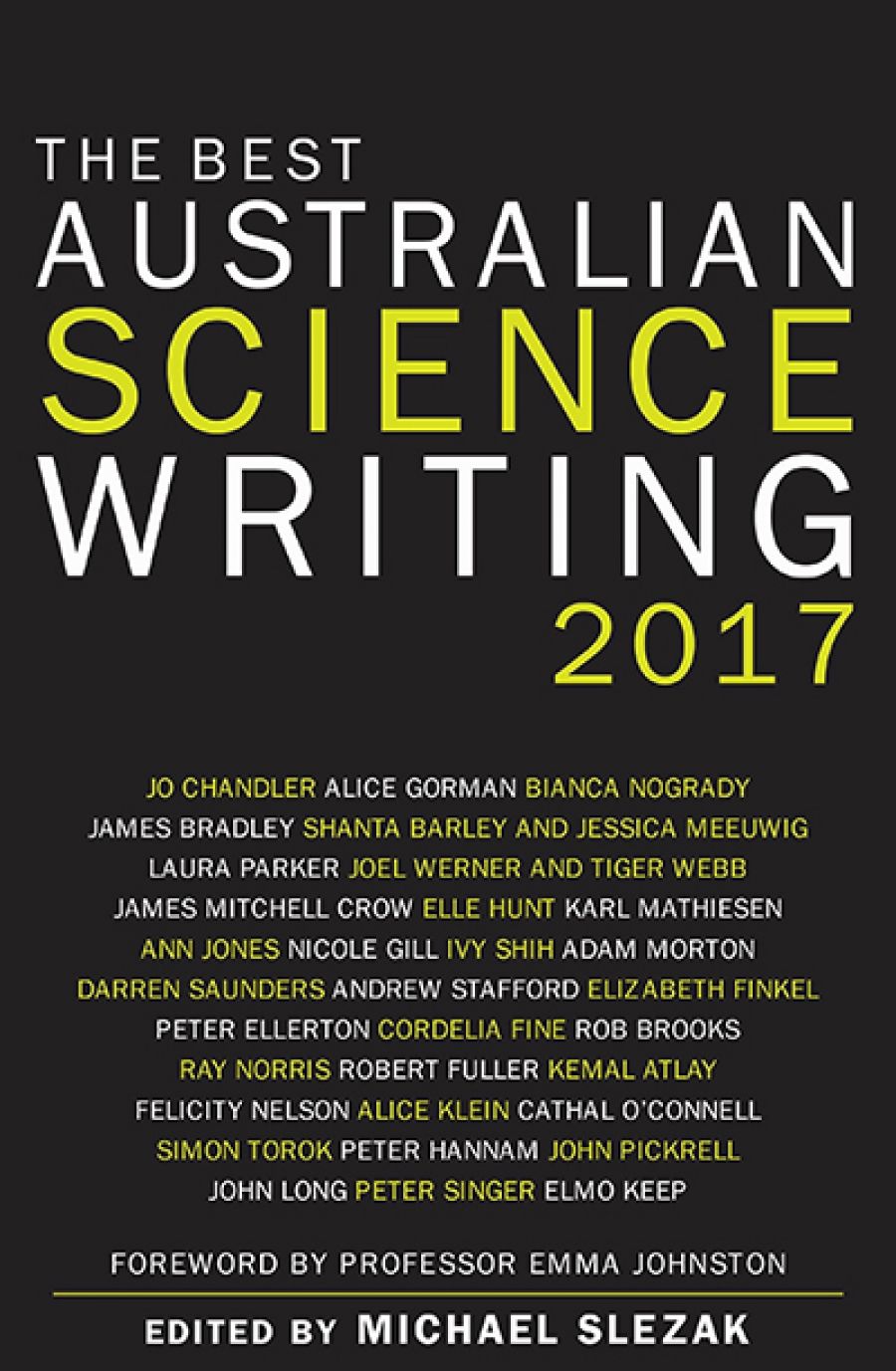
- Free Article: No
- Contents Category: Anthologies
- Custom Article Title: The Best Australian Science Writing 2017
- Custom Highlight Text:
It is a common misconception that scientists are not writers. As Professor Emma Johnston states in her foreword, writing is a fundamental part of the scientific process and innumerable volumes of scientific journals are published each year. These papers often employ dry, opaque language ...
- Book 1 Title: The Best Australian Science Writing 2017
- Book 1 Biblio: NewSouth, $29.99 pb, 291 pp, 9781742235554
Beyond collecting excellent science writing into a single volume, this anthology captures a snapshot of the most pressing challenges currently facing the planet. In his introduction, editor Michael Slezak states that he was keen to add timeliness to the list of selection criteria, insisting that each piece present particularly topical issues or research. Consequently, articles on environmental concerns are well represented, reflecting both the grim state of ecosystem health around the globe and growing levels of public anxiety over environmental issues.
Despite the decline in numbers of full-time science journalists, traditional media outlets like newspapers and science magazines are still well represented. Nevertheless, these are outnumbered by newer outlets and online media such as The Conversation, The Monthly, and The Saturday Paper. Interestingly, a third of the articles in this collection were authored by scientists and academics, demonstrating that scientific practitioners recognise the urgent need for quality science writing and the need to distil and communicate technical and scientific information to non-specialist audiences. This is exemplified by Alice Gorman’s article, which won this year’s Bragg UNSW Press Prize for Science Writing. Gorman is a space archaeologist and her lyrical essay exploring the environmental and cultural history of the landscape around Woomera and the Nullarbor Plain proves her to be as accomplished a writer as she is a scientist.
Jo Chandler’s ‘Grave Barrier Reef’ and James Bradley’s ‘Fish Have Feelings Too’ are two noteworthy examples of outstanding science journalism among many in this collection. Bradley recounts studies of intelligence and self-awareness among marine species and Chandler’s article is a devastating piece of environmental reportage, detailing a first-hand account of the impact of warming oceans on the Great Barrier Reef. The latter is one of several articles outlining environmental situations that are so critical and unresolved that, by the time of the anthology going to print, they required postscripts on developments since original publication.
Many of the articles are brief, offering snapshots of modern research and its practitioners (counting waterbird populations in the Murray Darling Basin; personal insights into the culture of cancer research; eradicating feral cats on Dirk Hartog Island). These short pieces serve to whet readers’ appetites, raising consciousness of issues and motivating further reading. Topical issues such as climate change (coral bleaching of the Great Barrier Reef; Tasmanian forest fires) and marine science (pygmy blue whale ecology; debunking the myth of megalodon survival; research on shark attacks in NSW) are well represented, as are more philosophical pieces that examine ethical questions (cephalopod consciousness; the use of ecological data gained from natural disasters; the hypothetical rights of aliens). Starwatchers are well catered for with articles on Aboriginal astronomy, the Big Data Telescope, and the influence of Indigenous star maps on Australian highway placement. Even the politics of science made an appearance in Morton’s article examining changes to research priorities at the CSIRO and the political and cultural context underlying these changes.
 A major coral bleaching event at the Great Barrier Reef in Australia. (Oregon State University, Wikimedia Commons)
A major coral bleaching event at the Great Barrier Reef in Australia. (Oregon State University, Wikimedia Commons)
While the shorter pieces lend the collection variety and colour, the longer articles prove to be the standouts. These long-form essays and articles demonstrate the benefits to readers that flow from allowing the space and time for extended discussion of complex scientific concepts and examination of their relevance for broader society. Peter Hannam’s clear-eyed assessment of both Australian shark attack statistics and the emerging technologies designed to protect humans who venture into the ocean is a welcome relief from the media hype around this contentious subject. Cathal O’Connell’s detailed yet highly readable account of the history of the search for anti-matter is an exemplary translation of quantum mechanics for the non-specialist, while Elmo Keep’s article on an abandoned pyramid in North Dakota is both a gripping piece of gonzo-reportage and an intriguing insight into historical responses to nuclear threat.
There has never been a more critical time for the exchange of knowledge between the scientific community and the general public. With climate scepticism seeming to gain traction around the globe despite the evidence for anthropogenic climate change, there is a crucial need for a scientifically literate populace. This engaging anthology, now in its seventh year, takes on this challenge, granting readers insight into Australian science and its practitioners, particularly those largely unknown outside specialist circles. We can only hope that it also promotes wider recognition of Australia’s talented and dedicated science journalists and fosters a media community that continues to value specialist writers. Given the current lack of well-informed governmental policy on climate change, excellent science writing is needed now more than ever.


Comments powered by CComment